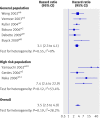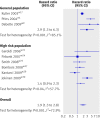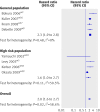The clinical importance of white matter hyperintensities on brain magnetic resonance imaging: systematic review and meta-analysis
- PMID: 20660506
- PMCID: PMC2910261
- DOI: 10.1136/bmj.c3666
The clinical importance of white matter hyperintensities on brain magnetic resonance imaging: systematic review and meta-analysis
Abstract
Objectives: To review the evidence for an association of white matter hyperintensities with risk of stroke, cognitive decline, dementia, and death.
Design: Systematic review and meta-analysis.
Data sources: PubMed from 1966 to 23 November 2009.
Study selection: Prospective longitudinal studies that used magnetic resonance imaging and assessed the impact of white matter hyperintensities on risk of incident stroke, cognitive decline, dementia, and death, and, for the meta-analysis, studies that provided risk estimates for a categorical measure of white matter hyperintensities, assessing the impact of these lesions on risk of stroke, dementia, and death.
Data extraction: Population studied, duration of follow-up, method used to measure white matter hyperintensities, definition of the outcome, and measure of the association of white matter hyperintensities with the outcome.
Data synthesis: 46 longitudinal studies evaluated the association of white matter hyperintensities with risk of stroke (n=12), cognitive decline (n=19), dementia (n=17), and death (n=10). 22 studies could be included in a meta-analysis (nine of stroke, nine of dementia, eight of death). White matter hyperintensities were associated with an increased risk of stroke (hazard ratio 3.3, 95% confidence interval 2.6 to 4.4), dementia (1.9, 1.3 to 2.8), and death (2.0, 1.6 to 2.7). An association of white matter hyperintensities with a faster decline in global cognitive performance, executive function, and processing speed was also suggested.
Conclusion: White matter hyperintensities predict an increased risk of stroke, dementia, and death. Therefore white matter hyperintensities indicate an increased risk of cerebrovascular events when identified as part of diagnostic investigations, and support their use as an intermediate marker in a research setting. Their discovery should prompt detailed screening for risk factors of stroke and dementia.
Conflict of interest statement
Competing interests: All authors have completed the unified competing interest form at
Figures




Comment in
-
Do white matter hyperintensities on MRI matter clinically?BMJ. 2010 Jul 26;341:c3400. doi: 10.1136/bmj.c3400. BMJ. 2010. PMID: 20660505 No abstract available.
-
White matter hyperintensities are associated with an increased risk of stroke, dementia and mortality.Evid Based Ment Health. 2011 Feb;14(1):1. doi: 10.1136/ebmh.14.1.1. Evid Based Ment Health. 2011. PMID: 21266598 No abstract available.
References
-
- Ylikoski A, Erkinjuntti T, Raininko R, Sarna S, Sulkava R, Tilvis R. White matter hyperintensities on MRI in the neurologically nondiseased elderly. Analysis of cohorts of consecutive subjects aged 55 to 85 years living at home. Stroke 1995;26:1171-7. - PubMed
-
- Garde E, Mortensen EL, Krabbe K, Rostrup E, Larsson HB. Relation between age-related decline in intelligence and cerebral white-matter hyperintensities in healthy octogenarians: a longitudinal study. Lancet 2000;356:628-34. - PubMed
-
- Pantoni L, Garcia JH. Pathogenesis of leukoaraiosis: a review. Stroke 1997;28:652-9. - PubMed
-
- Fazekas F, Kleinert R, Offenbacher H, Schmidt R, Kleinert G, Payer F, et al. Pathologic correlates of incidental MRI white matter signal hyperintensities. Neurology 1993;43:1683-9. - PubMed
-
- Van Swieten JC, van den Hout JH, van Ketel BA, Hijdra A, Wokke JH, van Gijn J. Periventricular lesions in the white matter on magnetic resonance imaging in the elderly. A morphometric correlation with arteriolosclerosis and dilated perivascular spaces. Brain 1991;114:761-74. - PubMed
Publication types
MeSH terms
LinkOut - more resources
Full Text Sources
Other Literature Sources
Medical
